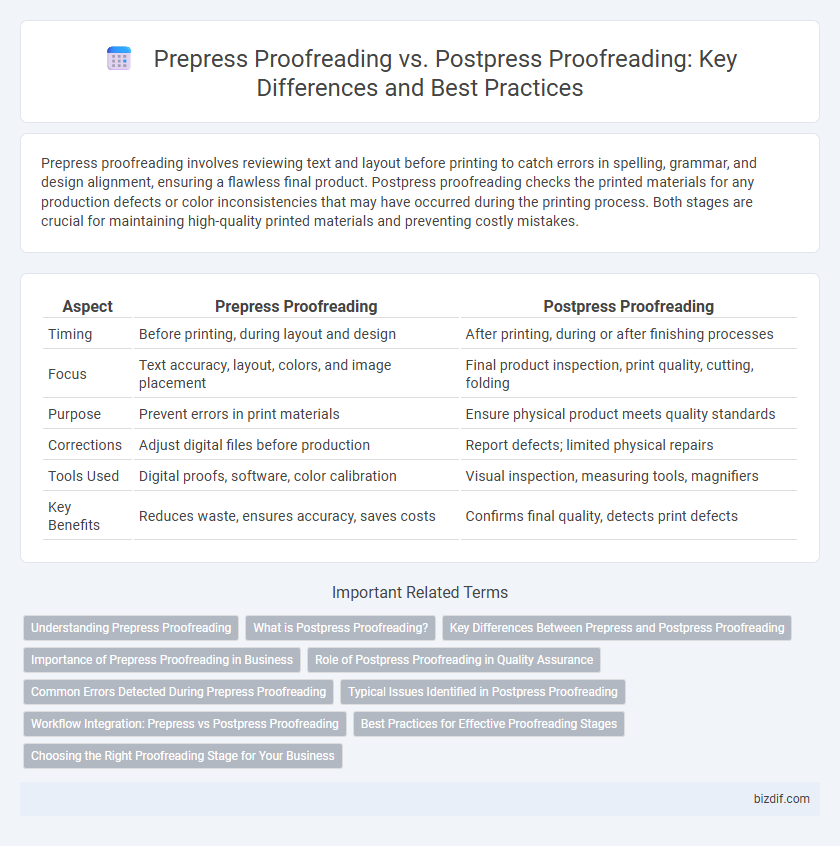Prepress proofreading involves reviewing text and layout before printing to catch errors in spelling, grammar, and design alignment, ensuring a flawless final product. Postpress proofreading checks the printed materials for any production defects or color inconsistencies that may have occurred during the printing process. Both stages are crucial for maintaining high-quality printed materials and preventing costly mistakes.
Table of Comparison
| Aspect | Prepress Proofreading | Postpress Proofreading |
|---|---|---|
| Timing | Before printing, during layout and design | After printing, during or after finishing processes |
| Focus | Text accuracy, layout, colors, and image placement | Final product inspection, print quality, cutting, folding |
| Purpose | Prevent errors in print materials | Ensure physical product meets quality standards |
| Corrections | Adjust digital files before production | Report defects; limited physical repairs |
| Tools Used | Digital proofs, software, color calibration | Visual inspection, measuring tools, magnifiers |
| Key Benefits | Reduces waste, ensures accuracy, saves costs | Confirms final quality, detects print defects |
Understanding Prepress Proofreading
Prepress proofreading involves meticulously reviewing digital or printed proofs before the final print production to catch typographical errors, incorrect fonts, and layout inconsistencies. This stage ensures that all text and design elements align with the client's specifications, minimizing costly mistakes during the printing phase. Effective prepress proofreading improves print accuracy, reduces waste, and speeds up production timelines by addressing issues early in the prepress workflow.
What is Postpress Proofreading?
Postpress proofreading occurs after the printing process, involving the inspection of printed materials for errors in color, alignment, and overall visual quality. This stage ensures that final products such as brochures, magazines, and packaging meet the specified standards before distribution. Postpress proofreading is crucial for detecting issues that only become apparent after printing, such as smudges, misprints, or trimming errors.
Key Differences Between Prepress and Postpress Proofreading
Prepress proofreading occurs before printing, focusing on verifying text accuracy, layout alignment, and color proofs to prevent errors early in production. Postpress proofreading takes place after printing, emphasizing the inspection of physical copies for defects like smudges, miscuts, or binding issues. The key differences lie in timing and focus, with prepress aimed at digital content corrections and postpress ensuring print quality and final product integrity.
Importance of Prepress Proofreading in Business
Prepress proofreading is critical in business to ensure accuracy and consistency before printing, preventing costly errors and reprints. Catching mistakes at this stage safeguards brand integrity and reduces material waste, improving overall production efficiency. Postpress proofreading, while useful for final quality checks, is less effective in correcting fundamental errors without significant delays and expenses.
Role of Postpress Proofreading in Quality Assurance
Postpress proofreading plays a critical role in quality assurance by identifying defects that may arise during the finishing processes, such as binding, cutting, and lamination. It ensures the final product matches the intended design and meets client specifications, preventing costly reprints and maintaining brand integrity. Detecting errors at this stage safeguards the overall production quality by verifying textual accuracy, color fidelity, and layout consistency after all printing and finishing steps are completed.
Common Errors Detected During Prepress Proofreading
Prepress proofreading commonly identifies errors such as typos, incorrect fonts, color inconsistencies, and layout misalignments before printing begins, ensuring design accuracy and preventing costly mistakes. It also detects issues like missing images, incorrect bleeds, and improper spacing that can affect print quality. Catching these errors early streamlines the production process and guarantees the final product meets the intended standards.
Typical Issues Identified in Postpress Proofreading
Typical issues identified in postpress proofreading include color inconsistencies, smudges, misalignments, and defective cuts that are often missed during prepress stages. Postpress proofreading also detects problems such as improper folding, binding errors, and surface damages like scratches or wrinkles on printed materials. Catching these defects ensures the final product meets quality standards before distribution.
Workflow Integration: Prepress vs Postpress Proofreading
Prepress proofreading integrates directly into the workflow before printing, allowing early detection and correction of textual and layout errors to prevent costly reprints. Postpress proofreading occurs after printing, focusing on quality control by identifying defects in the final printed materials that may have escaped prepress checks. Efficient workflow integration of prepress proofreading minimizes production delays, while postpress proofreading ensures the final product meets quality standards before distribution.
Best Practices for Effective Proofreading Stages
Prepress proofreading ensures accuracy by verifying text, layout, and color consistency before printing, preventing costly errors and misprints. Postpress proofreading focuses on inspecting final printed materials for defects such as smudges, alignment issues, or color discrepancies, ensuring product quality meets brand standards. Employing checklist-based reviews and utilizing digital proofing tools during both stages optimizes error detection and streamlines the production workflow.
Choosing the Right Proofreading Stage for Your Business
Choosing the right proofreading stage for your business depends on balancing accuracy and cost efficiency. Prepress proofreading catches errors before printing, reducing waste and reprint expenses, while postpress proofreading ensures the final product is flawless but may incur higher correction costs. Understanding your production timeline and budget helps determine whether early intervention or final review better suits your quality control needs.
Prepress Proofreading vs Postpress Proofreading Infographic

 bizdif.com
bizdif.com